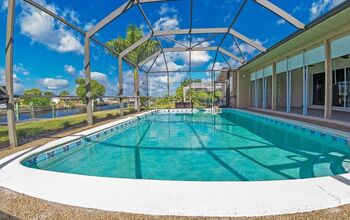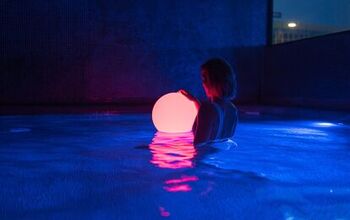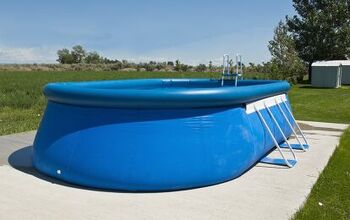Can You Put Chlorine Tablets in a Saltwater Pool? (Find Out Now!)

If you’re considering installing a saltwater pool in your backyard, you likely have a lot of questions. Saltwater pools serve as an alternative to traditional chlorine pools, and although you don’t have to manually add chlorine to a saltwater pool, they still contain chlorine. They have a much smaller amount, which is produced by a salt chlorine generator. This filtering system turns salt into chlorine, to effectively clean a saltwater pool.
However, what happens when your saltwater pool has a sudden need for chlorine? Perhaps you’re hosting a big gathering with more swimmers than the pool normally hosts. Or, you just experienced some serious rainfall for the last several days. In these cases, you wouldn’t want to wait for the electronic chlorine generator to slowly return the chlorine levels back to normal. But, can you put chlorine tablets in a saltwater pool?
To keep the chlorine level in your saltwater pool at about 3 parts per million, it may be necessary to add chlorine tablets to the water. Chlorine tablets can help supplement your pool with enough chlorine when it isn’t producing enough through the chlorine generator. Adding chlorine tablets can also help fight algae and bacteria from forming in your water.
You can also put liquid chlorine and chlorine granules directly into the pool to help return it back to optimum chlorine levels. While it is completely safe, there are some considerations that you must keep in mind when adding chlorine tablets into a saltwater pool.
Do You a Need Pool, Spa, or Hot Tub Contractor?
Get free, zero-commitment quotes from pro contractors near you.

Do Saltwater Pools Have Chlorine?
It is a common misconception that saltwater pools do not contain chlorine. They absolutely do use chlorine to purify water, but the difference is that the chlorine is essentially made on-site rather than being added in via chlorine tablets or granules. Saltwater pools have an electronic chlorine generator, which produces a small amount of chlorine and requires the system to operate for several hours in order to reach the proper amount.
Simply put, the filtering system turns salt into chlorine to clean the water. Whereas, with traditional chlorinated pools, the chlorine tablets or granules are physically added on a consistent basis for the same purpose. As such, the chlorine levels in a saltwater pool are more stable rather than fluctuating. Though, you still may have to shock the pool with higher levels of chlorine on occasion.
How Does a Saltwater Pool Make Chlorine?
Although the biggest benefit of a saltwater pool is the ability to have a safe, soft, and clean swimming pool, the truth is that saltwater pools stay clean by manufacturing their own artificial chlorine. In a saltwater pool, the system uses a piece of equipment called a chlorine generator. This machine converts the salt into a usable chlorine form to fight bacteria and algae.
In an average size pool, expect to pay about $1,700 to $2,500 for a chlorine generator. Although this system may be more expensive, you can expect your generator to last about 7 years before it will need to be replaced.
Can You Put Chlorine Tablets in a Saltwater Pool?
If you have a saltwater pool, it is certainly possible, likely even, that you’ll have to add in some chlorine eventually. To understand why this is the case, you need to understand that saltwater pools are still chlorine pools. As previously mentioned, the only difference is that saltwater pools electronically convert pool salt into chlorine.
So, if you’re wondering whether or not you can put chlorine tablets into a saltwater pool, the answer is yes. It does not matter to the pool how the chlorine is introduced to the water, only that it is. This means that you can add chlorine tablets, chlorine granules, and liquid chlorine to a saltwater pool and you’ll have no problems. In fact, there are certain situations where introducing chlorine to the pool manually is necessary.
What Causes Low Free Chlorine in Saltwater Pools?
Salt is added instead of chlorine to a saltwater pool, which the chlorine generator then converts into chlorine. When the free chlorine levels are too low, it usually means it is time to add more salt. Though, this may indicate some other things. For example, low chlorine readings may mean that you need to increase the chlorinator output or run it more often.
When low chlorine levels persist and both salt levels and chlorinator runtime are satisfactory, this may be a sign that the pump isn’t circulating water properly or there’s a problem with the generator cells. Regardless, you can eradicate the unfavorable effects of low chlorine – such as chlorine smells, algae growth, and hazy water – by shocking your saltwater pool.
What Is A Safe Level Of Chlorine in a Pool?
Even a saltwater pool must contain chlorine to help control bacteria and algae. A salt system will generate its own chlorine, but it may take some time. Additional chlorine tablets may be necessary to keep the chlorine in a pool at a safe level.
As a best practice, pools should be kept at about 3 parts per million of chlorine. If your system can only produce about 2 parts per million, adding a small chlorine tablet is enough to supplement your water with the correct level of chlorine to keep a safe and clean swimming environment.
Can Chlorine Help Prevent Algae Growth?
In a saltwater pool, chlorine is artificially created through a slow process that can take a long time to fully stabilize your pool. Unfortunately, while chlorine is being created, algae can take root in your system. Algae will grow even faster if you have high phosphate levels in your pool. Adding additional chlorine to your saltwater pool is the perfect way to find a quick solution to control nuisance algae.
If you notice that your pool is starting to turn green, it may be a good indication that your system is using chlorine as fast as the saltwater system can produce chlorine. In this instance, adding some chlorine tabs is the perfect way to shock the system and get algae back under control.
Is There a Downside to Too Much Chlorine?
Adding chlorine to your system can help maintain a safe level of dangerous bacteria, but there are some downsides to adding too much chlorine to your system. When you add too much chlorine, you could increase your stabilizer levels, called CYA. Usually, CYA should be between 30 and 50 parts per million. These levels are enough to protect your pool from UV degradation.
If your CYA climbs to 80 or 100 ppm, you run the risk of eliminating the chlorine’s efficacy. This means that although the chlorine may be high, the CYA levels create a chlorine block, which prevents the chemical from killing your bacteria and algae. Always closely monitor your CYA levels while adding more chlorine to your system.
How to Shock a Saltwater Pool
While most chlorinators have a super-chlorinating setting, this usually won’t add enough chlorine to clear relentlessly clouded water or kill algae in your pool. It is also simply not a substitute for shocking your pool. To successfully shock the pool, you need to increase the free chlorine concentration to 10 parts per million (ppm), or more.
This is done in the same manner as you would shock a traditional pool – by manually adding chlorine. Chlorine tablets, sodium hypochlorite, and calcium hypochlorite are all suitable for shocking. If the cyanuric acid concentration in your saltwater pool is too low, chlorine tablets are the ideal choice since they contain a stabilizer.
However, if the pool’s cyanuric acid concentration is already at the proper level, add pool chlorine, conventional bleach, or some sort of commercial shocking compound instead.
Look Out for Stabilizer Levels
If you add external chlorine to a saltwater pool on a regular basis to maintain the free chlorine levels, you need to keep an eye out for the stabilizer levels, or cyanuric acid (CYA). When the CYA level in a saltwater pool is kept between 30 and 50 parts per million, it shields the chlorine from UV degradation. With too low CYA, the sun will burn off the chlorine in your pool as quickly as the system can generate it.
Whereas, if the cyanuric acid level is too high – between 80 and 100 parts per million – the chlorine will no longer be effective at killing bacteria and algae in the pool. When this occurs, it is known as chlorine lock and the only way to fix it is to partially drain the pool and refill it. That said, it’s not an issue to manually add chlorine to a saltwater pool but you do want to keep an eye on the stabilizer levels and maybe consider using a type of chlorine that does not have CYA.
Note: Cyanuric acid is not as important for indoor pools as it is for outdoor pools. If you have an indoor saltwater pool, a cyanuric acid level between zero and 20 ppm is ideal.
What are the benefits of a saltwater pool?
In recent years, saltwater pools have increased in popularity exponentially. At the same time, these pools can tend to be slightly more expensive than a traditional chlorinated pool. They do have several benefits. Overall, saltwater pools are less expensive to maintain, and there is no need to store chlorine.
Plus, the water is softer, and the water is gentler on clothing and your skin. With a saltwater pool, you never have the strong chlorine smell to worry about. Several health benefits are loosely tied to swimming in saltwater pools compared to traditional chlorine pools.
Do You a Need Pool, Spa, or Hot Tub Contractor?
Get free, zero-commitment quotes from pro contractors near you.

Related Questions
What can help eliminate bacteria in addition to chlorine?
While adding chloramines to the water can help kill bacteria and eliminate cryptosporidium, you can also take extra precautions to give yourself a clean and safe pool. Using a UV, ozone, or AOP system is a great way to reduce the risk of crypto. Not only do these help to protect you, but they do so without raising your chlorine levels to a high level. These extra tools can help remove unnecessary chlorine from your water, keeping your chlorine or salt system completely safe.
Should saltwater pools smell like chlorine?
While saltwater pools still contain chlorine, there should be no detectable chlorine odor. In fact, if you do have a chlorine smell coming from your saltwater pool, this indicates an imbalance.
Are saltwater pools no maintenance?
Saltwater pools aren’t completely no maintenance, but they do require significantly less maintenance than regular chlorine swimming pools. You still must test the free chlorine levels and PH every week, and you should also check the salt cell about every three months.

Jessica considers herself a home improvement and design enthusiast. She grew up surrounded by constant home improvement projects and owes most of what she knows to helping her dad renovate her childhood home. Being a Los Angeles resident, Jessica spends a lot of her time looking for her next DIY project and sharing her love for home design.
More by Jessica Stone



























